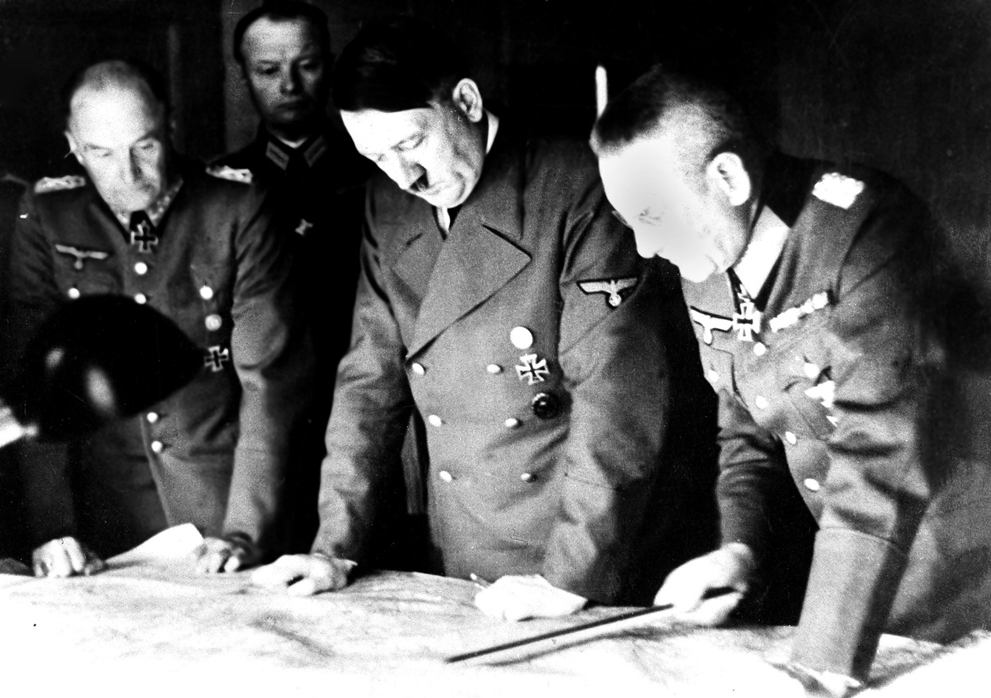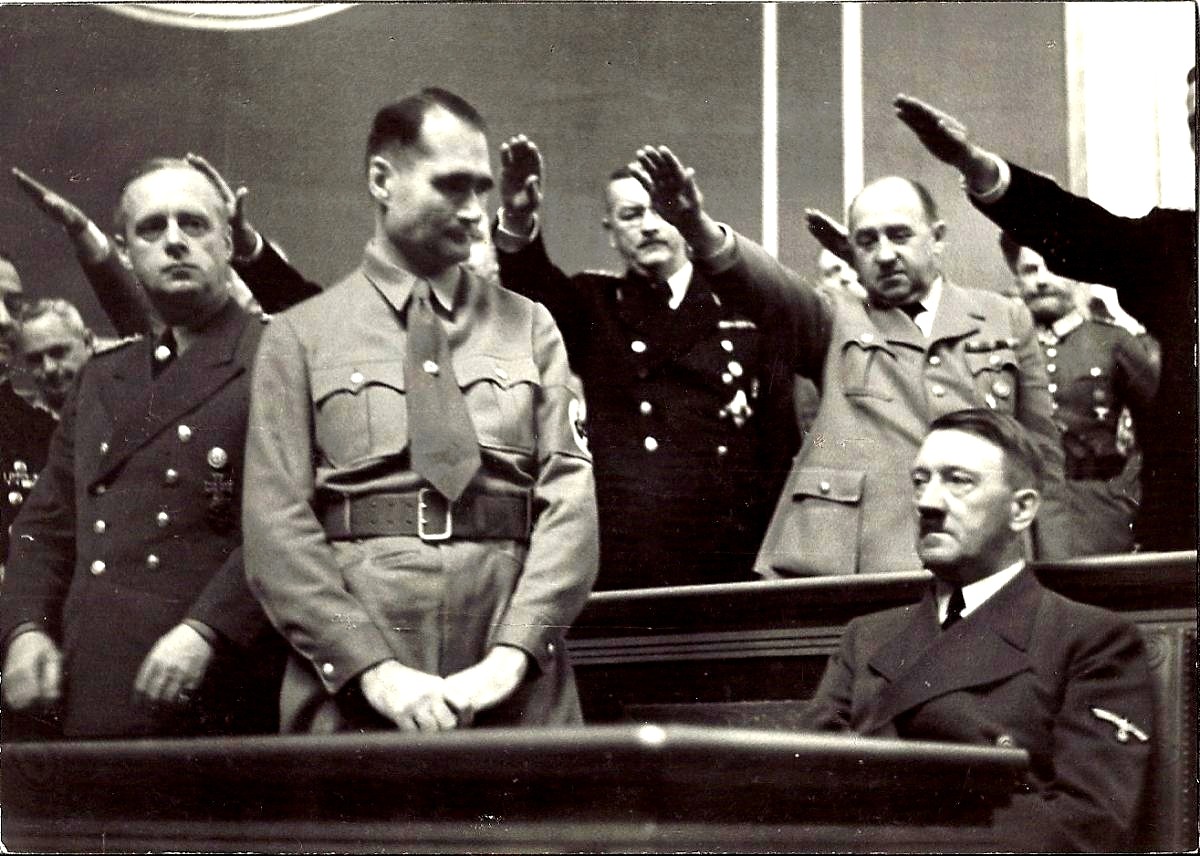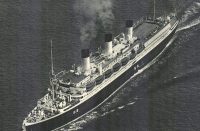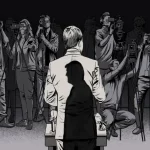The context
A little context is mandatory to perfectly define the message that Rudolf was carrying. The outstanding works of researchers such as Anthony Sutton and Charles Higham are critical in our understanding of the real historical context surrounding the creation of the Nazi war machine. When in 1933 Hitler accessed to the Chancellery in the Reichstag, Germany was in financial limbo. Worst, the nation was in the gutters of limbs. It owed tens of billions in reparations for WW1, and its inability to comply had provoked a gargantuan-scale inflation crisis on the mark in 1923 that cut the currency to 1/500 billionth of its original value. To make matters worse, the country suffered along everyone the world Crash of 1929. So how in the world was Germany able to eradicate unemployment and create the most formidable military machine the world had ever seen in just 6 years? Over achievement is under rated when it comes to explain the German Miracle of the ’30s.
The first tool that is required in our investigator’s toolbox is to admit the very documented fact that the Bank of England, controlled by the Rothschild family, had been involved in the financing of the Nazis. It had become a common procedure for the rich European banking family to fund enemies as well as allies, in order to make profits from both sides of wars since Napoleon. The self-proclaimed French Emperor of the early 19th century had been hired as a proxy by Rothschild who wanted to impose his private central banks in the conquered countries. So, the heirs of the Rothschild family saw in Hitler their next Napoleon, who would submit rival colonial empires like Belgium, the Netherlands and France, as well as destroying the mighty USSR, in order to singlehandedly take the reins of the New World Order, which is simply the economical and political ruling of the whole planet by a handful of bankers. Even though the New World Order sounds like a supercharged conspiracy theory, it’s an indisputable and quite simple concept.
 Even if the infamous banking family helped the Führer, the bulk of the money that flooded Germany between 1933 and 1939 didn’t come from England, but mainly from the United States of America. Not the American government per say, but more specifically American bankers and industries. Through white-washing money schemes, through the newly founded Bank of International Settlements and through joint venture investments in Germany with their companies such as Standard Oil, GM, Ford, ITT, General Electric or IBM; Rockefeller, Morgan, Harriman, DuPont, Ford and a few other billionaires were mainly responsible for what is known as the German Miracle, that now looks more like an American Dream. Thanks to British and American investments, Nazi Germany went from the poorest country in Europe to the second world economy. Even though education won’t tell you anything about it, the overwhelming help that Hitler got from the West is never disputed because it was exposed in numerous US inquiries, senatorial committees and court cases based on the Trading with the enemy Act adjusted by President Roosevelt in 1933, but the verdicts always came after the usual “we didn’t know what Hitler was going to do next” explanation. As if Mein Kampf, published in 1925, hadn’t been clear enough on the matter.
Even if the infamous banking family helped the Führer, the bulk of the money that flooded Germany between 1933 and 1939 didn’t come from England, but mainly from the United States of America. Not the American government per say, but more specifically American bankers and industries. Through white-washing money schemes, through the newly founded Bank of International Settlements and through joint venture investments in Germany with their companies such as Standard Oil, GM, Ford, ITT, General Electric or IBM; Rockefeller, Morgan, Harriman, DuPont, Ford and a few other billionaires were mainly responsible for what is known as the German Miracle, that now looks more like an American Dream. Thanks to British and American investments, Nazi Germany went from the poorest country in Europe to the second world economy. Even though education won’t tell you anything about it, the overwhelming help that Hitler got from the West is never disputed because it was exposed in numerous US inquiries, senatorial committees and court cases based on the Trading with the enemy Act adjusted by President Roosevelt in 1933, but the verdicts always came after the usual “we didn’t know what Hitler was going to do next” explanation. As if Mein Kampf, published in 1925, hadn’t been clear enough on the matter.
The War
Things looked fine for England at the start. Hitler quickly filled the mandate he had on top of his agenda by invading the colonial trio of Netherlands-Belgium-France in a month and a half. The complicity of the British Army is appalling in the lightening speed success of the Wehrmacht. The four “allied” countries had together 149 divisions, or 2 900 000 men, while the Wehrmacht had 2 750 000 men split in 137 divisions. Allied countries had more canons, more tanks, more ammunition, yet France, a country of 70 million people, gave up in one month! History tried to explain this lame defeat by the unstoppable German blitzkrieg, but this blitz was advancing at 15 kms/hour, when it was moving at all. One would think that there was plenty of time to aim at this jogging pace. Russian historian Nikolay Starikov has looked thoroughly over what happened on the ground to find some plausible clues to the quick defeat of France in June 1940, which can be summed up very simply: Churchill betrayed France, as clear as crystal, by purposely failing the French General Weygan’s plan of defense. This grand treason is also circumstantial evidence of what self-proclaimed virtuous nations can do to each other that extends to the destruction of an ally for your own benefit. But Hitler was yet to reward Churchill for his great help in the conquest of France, so he turned a blind eye on the evacuation of the British army in Dunkirk that history explains as a “strategic blunder” from Hitler. Reality does explain rather mysterious events of the war that only find dubious explanations in our books; another unexplainable event was the vicious attack of the British Navy on France’s fleet in July 1940, presumably to avoid that the ships fall in German hands. It turns out that it was another very positive step in order to complete the destruction of the French colonial empire, as were the operations by Rothschild-funded Japan that were ousting the French from Indochina at the same time. From the British point-of-view, the Wehrmacht pit-bull would next leave France and jump at the throat of USSR.
Against Churchill’s expectations, the next few months were devoted to the Battle of Britain that started by a German invasion of the Channel Islands, from where German planes could start bombing England. Churchill was evil, but he wasn’t so stupid as to not understand that Hitler had stopped working for England. Whatever the deal was, the RAF defense definitely slowed down any advantage that the Luftwaffe could gain over the British skies and after the horrendous mutual bombings of London and Berlin, Germany decided on October 12th 1940 to postpone its operation Sea Lion designed to invade England with ground troops. It looked like Germany and England were in a stalemate by the winter of 1940-1941.
If you’re acquainted with the official history, you would think that Hitler’s attack on great American allies such as France and England would have motivated the USA to enter the war at once, but no. Not at all. President Roosevelt even declared on October 30th 1940 that “his boys wouldn’t go to war”. This policy would extend until the spring of 1941, and not a single move, decision or sanction was undertaken by the US government that really looked like it had decided to never get involved in WW2.
 The theater of war moved into North Africa and the Middle East for the winter, where people could kill and maim each other under more pleasant and milder climate. With the melting of ice and snow in the spring of 1941, Hitler was facing two options: launch Sea Lion and invade England, or leave the West in peace and launch Barberossa against the Soviet Union. Both were major operations that couldn’t be sustained by Germany at once, and Hitler had to make a choice. He also knew that the invasion of England would’ve mortally crippled the Rothschild family’s influence on the planet and paved the way for Wall Street to rule the world at will.
The theater of war moved into North Africa and the Middle East for the winter, where people could kill and maim each other under more pleasant and milder climate. With the melting of ice and snow in the spring of 1941, Hitler was facing two options: launch Sea Lion and invade England, or leave the West in peace and launch Barberossa against the Soviet Union. Both were major operations that couldn’t be sustained by Germany at once, and Hitler had to make a choice. He also knew that the invasion of England would’ve mortally crippled the Rothschild family’s influence on the planet and paved the way for Wall Street to rule the world at will.
Well folks, that’s precisely when Rudolf Hess was parachuted in England on May 10th 1941. Without any form of speculation, it now appears very clearly that Hitler didn’t want to take this mighty decision alone, and that he didn’t want the rest of the world to know about his dilemma.
The Proposal
According to an article published in May 1943 by the magazine American Mercury, here’s what the Führer proposed to England through Rudolf Hess:
Hitler offered total cessation of the war in the West. Germany would evacuate all of France except Alsace and Lorraine, which would remain German. It would evacuate Holland and Belgium, retaining Luxembourg. It would evacuate Norway and Denmark. In short, Hitler offered to withdraw from Western Europe, except for the two French provinces and Luxembourg [Luxembourg was never a French province, but an independent state of ethnically German origin], in return for which Great Britain would agree to assume an attitude of benevolent neutrality towards Germany as it unfolded its plans in Eastern Europe. In addition, the Führer was ready to withdraw from Yugoslavia and Greece. German troops would be evacuated from the Mediterranean generally and Hitler would use his good offices to arrange a settlement of the Mediterranean conflict between Britain and Italy. No belligerent or neutral country would be entitled to demand reparations from any other country, he specified.
 Basically, Hitler wanted to be a partner in a British-led New World Order by taking care of Eastern Europe. He even spoke in front of the Reichstag about the option of peace with England. The American Mercury article concluded that these very likely terms offered by Hitler to be implemented on the spot were swiftly rejected by Churchill since none of the conditions ever happened, but in reality, they were terms to be applied after the war, after the destruction of the USSR by Germany. But the Red Army had other future plans, of course.
Basically, Hitler wanted to be a partner in a British-led New World Order by taking care of Eastern Europe. He even spoke in front of the Reichstag about the option of peace with England. The American Mercury article concluded that these very likely terms offered by Hitler to be implemented on the spot were swiftly rejected by Churchill since none of the conditions ever happened, but in reality, they were terms to be applied after the war, after the destruction of the USSR by Germany. But the Red Army had other future plans, of course.
There is no doubt that we are now deep into speculation about whatever proposal Hess made to England, but in reality, this wasn’t the main point of his mission. And independently of the exact terms that were discussed, what was to happen next dissipates any cloud of mystery, be it thin or thick.














Very interesting episodes. More real historical context; see “General Ludendorff Breaks with Hitler” (JTA archive).
(General Ludendorff, no one less than the most prominent early National Socialist, denounces Hitler as a dangerous betrayer of the German people and an associate of the Freemasons, i.e. a Rothschild proxy) Ludendorff wasn’t fooled, but how to trap other nationalist German generals a decade later?
A load of regurgitated bullshit. I recommend u Mike King’s site, http://tomatobubble.com so u will stop the Zio-propaganda against National Socialism.
This article goes no where
Interesting. He should contact me with a real ID. I can’t see “Sylvain LaForest” for the trees.look up LAST MAN IN SPANDAU in YouTube
Tom@lipscomb.net
Boy oh boy typical fantasy story. Please find something useful to do with your life and not write such complete drivel.
Buttressing the authors’ theory, many are not aware that Churchill proposed a hostile takeover over France prior to its surrender to Germany in 1939.
In December 1939, Jean Monnet of the French Economic Mission in London became the head of the Anglo-French Coordinating Committee, which coordinated joint planning of the two countries’ wartime economies. The Frenchman hoped for a postwar United States of Europe and saw an Anglo-French political union as a step toward his goal. He discussed the idea with Neville Chamberlain, Winston Churchill’s assistant Desmond Morton, and other British officials.[1]
In June 1940, French Prime Minister Paul Reynaud’s government faced imminent defeat in the Battle of France. In March, they and the British had agreed that neither country would seek a separate peace with Nazi Germany. The French cabinet on 15 June voted to ask Germany for the terms of an armistice. Reynaud, who wished to continue the war from North Africa, was forced to submit the proposal to Churchill’s War Cabinet. He claimed that he would have to resign if the British were to reject the proposal.[1]
The British opposed a French surrender, and in particular the possible loss of the French Navy to the Germans, and so sought to keep Reynaud in office. On 14 June British diplomat Robert Vansittart and Morton wrote with Monnet and his deputy René Pleven a draft “Franco-British Union” proposal. They hoped that such a union would help Reynaud persuade his cabinet to continue the war from North Africa, but Churchill was sceptical when on 15 June the British War Cabinet discussed the proposal and a similar one from Secretary of State for India Leo Amery. On the morning of 16 June, the War Cabinet agreed to the French armistice request on the condition that the French fleet sail to British harbors. This disappointed Reynaud, who had hoped to use a British rejection to persuade his cabinet to continue to fight.[1]
Reynaud supporter Charles de Gaulle had arrived in London earlier that day, however, and Monnet told him about the proposed union.[1] De Gaulle convinced Churchill that “some dramatic move was essential to give Reynaud the support which he needed to keep his Government in the war”.[2] The Frenchman then called Reynaud and told him that the British prime minister proposed a union between their countries, an idea which Reynaud immediately supported. De Gaulle, Monnet, Vansittart, and Pleven quickly agreed to a document proclaiming a joint citizenship, foreign trade, currency, war cabinet, and military command. Churchill withdrew the armistice approval, and at 3 p.m. the War Cabinet met again to consider the union document. Despite the radical nature of the proposal, Churchill and the ministers recognized the need for a dramatic act to encourage the French and reinforce Reynaud’s support within his cabinet before it met again at 5pm.[1]
The final “Declaration of union” approved by the British War Cabinet stated that[1]
France and Great Britain shall no longer be two nations, but one Franco-British Union. The constitution of the Union will provide for joint organs of defence, foreign, financial and economic policies. Every citizen of France will enjoy immediately citizenship of Great Britain, every British subject will become a citizen of France.
Churchill and De Gaulle called Reynaud to tell him about the document, and they arranged for a joint meeting of the two governments in Concarneau the next day. The declaration immediately succeeded in its goal of encouraging Reynaud, who saw the union as the only alternative to surrender and who could now cite the British rejection of the armistice.[1]
Other French leaders were less enthusiastic, however. At the 5 p.m. cabinet meeting, many called it a British “last minute plan” to steal its colonies, and said that “be[ing] a Nazi province” was preferable to becoming a British dominion. Philippe Pétain, a leader of the pro-armistice group, called union “fusion with a corpse”. While President Albert Lebrun and some others were supportive, the cabinet’s opposition stunned Reynaud. He resigned that evening without taking a formal vote on the union or an armistice, and later called the failure of the union the “greatest disappointment of my political career”.[1]
Reynaud had erred, however, by conflating opposition to the union—which a majority of the cabinet almost certainly opposed—with support for an armistice, which it almost certainly did not. If the proposal had been made a few days earlier, instead of the 16th when the French only had hours to decide between armistice and North Africa, Reynaud’s cabinet might have considered it more carefully.[1]
Pétain formed a new government that evening, which immediately decided to ask Germany for armistice terms. The British cancelled their plans to travel to Concarneau.[1]
There is probably truth to this article:https://www.youtube.com/watch?v=0kCivW128Xs
With Hitler they tried, but it went wrong. With Franco it was a success.
Really interesting article.
Thank you for sharing it with us!!
Is there part 3?
This policy would extend until the spring of 1941, and not a single move, decision or sanction was undertaken by the US government that really looked like it had decided to never get involved in WW2.
Interesting article, till I got to the above part. FDR was chomping at the bit to get into WWII, regardless of what he told the American public. That’s why he had the US Navy shooting at German ships that refused to return fire, knowing the consequences. When the Germans didn’t fall for that, FDR came in the back door by waging economic war against Japan, who told FDR to knock it off or it would mean war. And that’s what happened and gave FDR the excuse to enter the European theater of conflict.
BTW, France might of had more tanks, but French tanks were no match for German tanks.
This policy would extend until the spring of 1941, and not a single move, decision or sanction was undertaken by the US government that really looked like it had decided to never get involved in WW2.
Interesting article, till I got to the above part. FDR was chomping at the bit to get into WWII, regardless of what he told the American public. That’s why he had the US Navy shooting at German ships that refused to return fire, knowing the consequences. When the Germans didn’t fall for that, FDR came in the back door by waging economic war against Japan, who told FDR to knock it off or it would mean war. And that’s what happened and gave FDR the excuse to enter the European theater of conflict.
BTW, France night of had more tanks, but French tanks were no match for German tanks…
Two books on the subject:
“Hess and the Penguins” (Joe Farrell)
“Double Standards” (Price, et al.)
Both admit the official story is untrue. Most speculation is just that. Hess surely DID have Hitler’s approval since the Hess family was rewarded with a pension after Rudolf was captured. The pension was actually made out in the name of the alias Hess offered in Scotland (!)
One more thing is that very early on in “Hess’s” Spandau years, a dentist examined his teeth against a set of x-rays from pre-war Germany. The dentist concluded that whomever the Spandau prisoner was, the dental records explicitly ruled out the possibility the prisoner could have been the Rudolf Hess.
The rest will stay a mystery.
This Part II is just Jew-influenced Anthony Sutton’s distortion (propaganda) of history;.
The Big issue is that the English Royals were ole Northern Germans, and if Hess could manage getting the Royals and Germany to become one, the Rothschilds would not make any money betting against Germany. The West had a ton of money invested in Germany and that would advance the West’s NWO and not the English Colonial System NWO. Churchill forced the war, as England long set up the Germans to take the hit against the rising power of Russia and their counter economic system against the Rothschilds.
So, Churchill set up Germany to go hard against the Russians and grind both into the ground. Churchill delayed the Overlord invasions by playing games in the Med area.
Great article.Reveals the truth about WW2
it is a naturally occurring, yellowish-black liquid found inside the earth surface. And it can be refined as a fuel. The consumption of petrol and diesel is increasing day-by-day as the world is developing. The rapid increase in demand of petrol and diesel leads to increase in the price of the petrol and diesel product. It is one of the most important source for economic development of the country. https://hs.news/bajwas-tenure-extended-in-pakistan/
This article is again very inaccurate and paints a different picture than reality altogether. Ford in Germany? Or in Europe at all? Germany had the Volkswagen, France the Renault, Netherlands the Daf, Italy the Fiat etc.. Ford was eating his heart out for not getting one iota of interest from Europe. And so on and so forth.
The self-proclaimed French Emperor of the early 19th century = The self-proclaimed “president in charge” Juan Guaidó
The download, installation, and setup method of Canon Printer is straightforward and can be executed smoothly via https://www.cannonij.com/ in just a few steps.
To produce the highest quality work and services for every client, on every project and service. We are dedicated to helping your business leverage IT solutions to bring your business to the next level. search Engine Optimization
Casi todos los tragamonedas de video prohibidos tambien ofrecen algunos amables de un mini-juego. Esto puede ser un azaroso viaje a las profundidades de una piramide o importante observacion en el Despoblado Oeste…
Casi todos los tragamonedas de video prohibidos tambien ofrecen algunos amables de un mini-juego. Esto puede ser un azaroso viaje a las profundidades de una piramide o importante observacion en el Despoblado Oeste….!